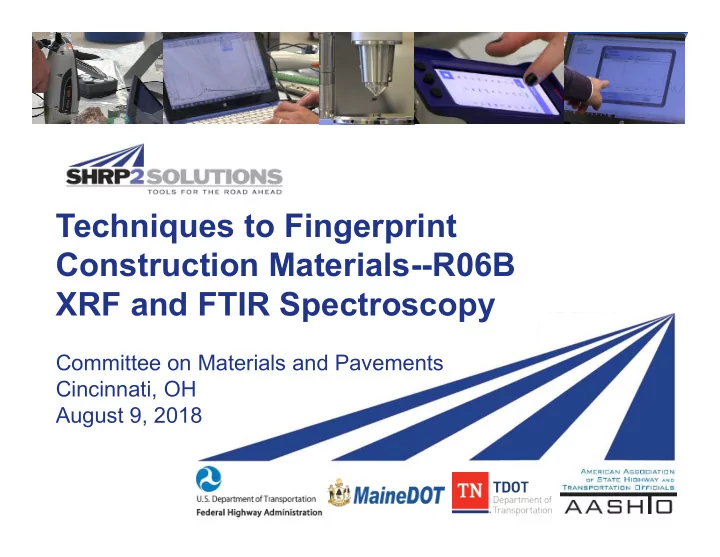

Techniques to Fingerprint Construction Materials--R06B XRF and FTIR Spectroscopy Committee on Materials and Pavements Cincinnati, OH August 9, 2018
Techniques to Fingerprint Construction Materials (R06B) Challenge • Verify materials without sampling delays Solution • Technologies to verify specific construction materials in real time • Technologies that can be used at the project site to determine specification compliance | 2
Potential Benefits • Rapid testing on site or in the lab • Reduce testing time and cost • Minimize noncompliance risk | 3
R06B Technologies X-Ray Fluorescence Spectroscopy (XRF) Rapid elemental analysis of materials Specific application developed in R06B— testing traffic paints for Ti content | 4
XRF Advantages and Limitations Advantages • Pre-calibrated for wide range of elements • Automatic reading—no analysis • 1-3-minute testing time • Little or no sample prep required • No maintenance required • Numerous applications Limitations • Requires user certification • Upper and lower limits—different calibrations needed for trace metals vs. ores | 5
Fourier Transform Infrared (FTIR) • Identifies compounds • Simple testing process • Analysis more difficult than XRF | 6
R06B—Maine • XRF – Chlorides in bridge deck cores – Titanium in traffic paint – REOB in PG Binder – SS Rebar – Galvanized coating thickness – Glass Beads – lead, arsenic – Presence of RAS in HMA? • FTIR – Polymer in PG Binder – Library of all Binders – Lime in HMA | 7
R06B—Maine Quantitative Qualitative | 8
Chloride Content – Bridge Deck Cores • Current method: AASHTO T 260 (Gran Plot Method) – Requires nitric acid and silver nitrate – Numerous steps – 10 tests/day • XRF method – No chemicals – 25+ tests/day – Less training required | 9
Chloride Content – XRF method | 10
Chloride Content – Bridge Deck Cores • Split-sample comparison – Evaluated numerous binding agents for pelletized samples, XRF settings, direct measurement of concrete – Selected the settings that provided the best correlation on a limited amount of measurements vs. titration values – Expanded population of comparisons – In-progress statistical validation Item Levels Details Analysis Mode 3 AllGeo and Two Mining Modes Time Breakdown 2 5/5/5/45 & 15/15/15/15 Binding Agent 6 None and 5 recommended agents Binding % 2 5% & 10% Replicates 3 Three measurements on each pellet | 11
Surface Testing of Core Slices a c b Top, bottom, edge of slice Average of all readings v. Titration R 2 ≈ 0.91 - Exposed aggregate a problem - Higher variability b | 12
Pulverized specimens 0.6 y = 0.9672x N = 282 samples Titration Chloride Content (%) 0.5 R² = 0.9659 0.4 0.3 0.2 0.1 0.0 0.0 0.1 0.2 0.3 0.4 0.5 0.6 XRF Chloride Content (%) | 13
Chloride Content – Bridge Deck Cores • Conclusions from study – Pellets of pulverized material superior to surface readings of slices – No binding agent required – In process of: • testing lab-prepared reference samples • validating correlation with independent split-sample comparisons | 14
Stainless steel rebar | 15
R06B—Tennessee • XRF Silica and Calcium Carbonate in Limestone Titanium in Thermoplastic Glass Beads – lead, arsenic REOB in Binder? Galvanized coating thickness? • FTIR Polymer in PG Binder Library of all Binders PPA in Binder | 16
Heavy Metals in Glass Beads • Current Practice: Tennessee requires every lot to be tested with EPA tests 3052, 6010B, or 6010C. • Future Method: Perform XRF testing on every lot. Allow manufacturer to Certify lots to Federal Aid Standard. | 17
Silica in Limestone • Currently tested by standard-less program on WDXRF in Lab. • Handheld can perform same testing but still requires a lot of sample prep to be accurate. | 18
Titanium in Thermoplastic • Current Practice: Tennessee currently accepts thermoplastic on certification. • Future Practice: The handheld can perform verification testing in the field/lab on Thermoplastic. There may be some issues with some fillers in the Thermoplastic. | 19
Future for this Product in TN • Looking into other materials Following Maine and using XRF as a rapid test for Chloride Content of Bridge Decks. Using the XRF and FTIR to detect REOB’s and PPA’s in our Binders. Using the FTIR to verify Qualified Products List materials, such as Texture Coating and Additives for Asphalt and Concrete. | 20
What’s Next for R06B The Future ‒ Webinar - August 22, 2018 ‒ https://collaboration.fhwa.dot.gov/dot/fhwa/WC/Lists/Semi nars/DispForm.aspx?ID=1706 ‒ Peer Exchange - September 26-27, 2018 ‒ https://fs6.formsite.com/Mrussell/form204/index.html ‒ Regional User Producer Group Meetings? ‒ Others? | 21
For More Information on R06B Contacts Additional Resources: Kate Kurgan GoSHRP2 fhwa.dot.gov/GoSHRP2 Website: AASHTO Product Lead kkurgan@aashto.org AASHTO SHRP2 http://shrp2.transportation.org Website: Steve Cooper R06B Product Coming soon FHWA Product Lead Page stephen.j.cooper@dot.gov Maria Chrysochoou Subject Matter Expert maria.chrysochoou@uconn.edu Terry Arnold Technical Expert terry.Arnold@dot.gov | 22
Recommend
More recommend